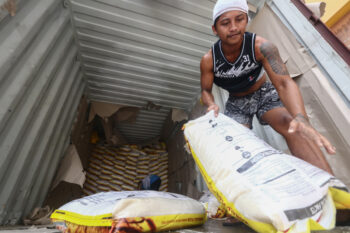GENERAL SANTOS CITY (MindaNews/21 July) – Residents in General Santos City are often asked what is in here that attracted big mall operators “to pitch tents” in this port city made more famous for its succulent yellowfin tuna.
For close to two decades now, since the opening of the international-class airport in 1997, hundreds and hundreds of tons of fresh tuna have been shipped out from the city. And thousands of metric tons of canned tuna have sailed out of Makar Wharf in General Santos to destinations throughout the world.
At one point, seven of the country’s eight tuna canneries were operating at almost three shifts a day – 24/7 – directly employing close to 15,000 manufacturing workers.
But the tuna industry has obviously seen better days.
Restrictive tuna trade issues, changing weather patterns and declining tuna stocks have drastically cut down tuna production as well as manufacturing outputs.
The windfall profits of tuna producers when the peso exchange rate dramatically rose vis-à-vis the dollar in 1997 are the very same factors that are contributing to its decline: rising costs of production and raw materials.
Canned tuna productions are now down to a single shift; twice some other times in a couple of the remaining six tuna canneries in the city. At least 20 percent of the fishing vessels have been grounded due to rising fuel costs and the continuing two-year ban on international tuna fishing. Tuna producers are looking beyond the industry to channel their investments. There is real danger that the tuna industry will suffer the same fate as the livestock industry, once the city’s top “export” commodity.
But despite the acknowledged decline of tuna production and revenues generated from it, General Santos continues to thrive as hub of business in Region 12 or the provinces that once comprised the undivided Cotabato Empire.
Two of the country’s biggest mall operators are already in the city with SM Holdings announcing a September opening of its three-storey SM Mall along Santiago St. Robinson’s Place earlier opened in October 2009. Gaisano, of course, has been here for close to two decades while KCC Mall is setting sights at expanding its store to the nearby lot owned by SAFII.
Housing projects are again up and the construction business is rebounding after almost a decade of lull.
So where is the money coming from? Why is consumer spending on the rise?
One needs to look outside in order to know what’s happening inside.
In 2009, Region 12 sent the most number of overseas Filipino workers (OFWs) in Mindanao abroad with more than 4.2 percent of the country’s 1,910,000 registered migrant workers – up from 2.8 percent in 2004. It has surpassed Region 11 (Davao Region) as the most prolific exporter of Filipino migrant workers in Mindanao.
In 2004, total remittances of OFWs from Central Mindanao was pegged at P905,985,000.
No figures have been released for 2009 but the 33-percent spike in the number of OFWs from Region 12 during the year could only explain for the increase in the demand for more housing units and consumer goods, mostly appliances and other household needs.
There is likewise a noticeable increase in the number of secondhand car traders throughout the region.
General Santos, without doubt, has benefited from the windfall of this modern day Filipino diaspora as residents from nearby provinces are making the city their preferred destination for shopping and recreation.
In an article written by Alvin Ang of the Social Researtch Center of the University of Santo Tomas, he said it is no longer far fetch that the presence of Robinson’s and SM malls will become the future indicators, if not already, of development in the Philippines. He aptly observed that these two mall businesses are mainly located in regions where there are large concentration of OFWs. That’s more than 80,000 OFWs from Region 12 in 2009.
In 2004, the average remittance per OFW in the region was P43,848. Even at that constant figure, that means P3.5 billion of disposable income infused into the region’s economy in 2009.
We are now in 2011. There is no indication that this trend will not continue. (Edwin Espejo / MindaNews contributor)







